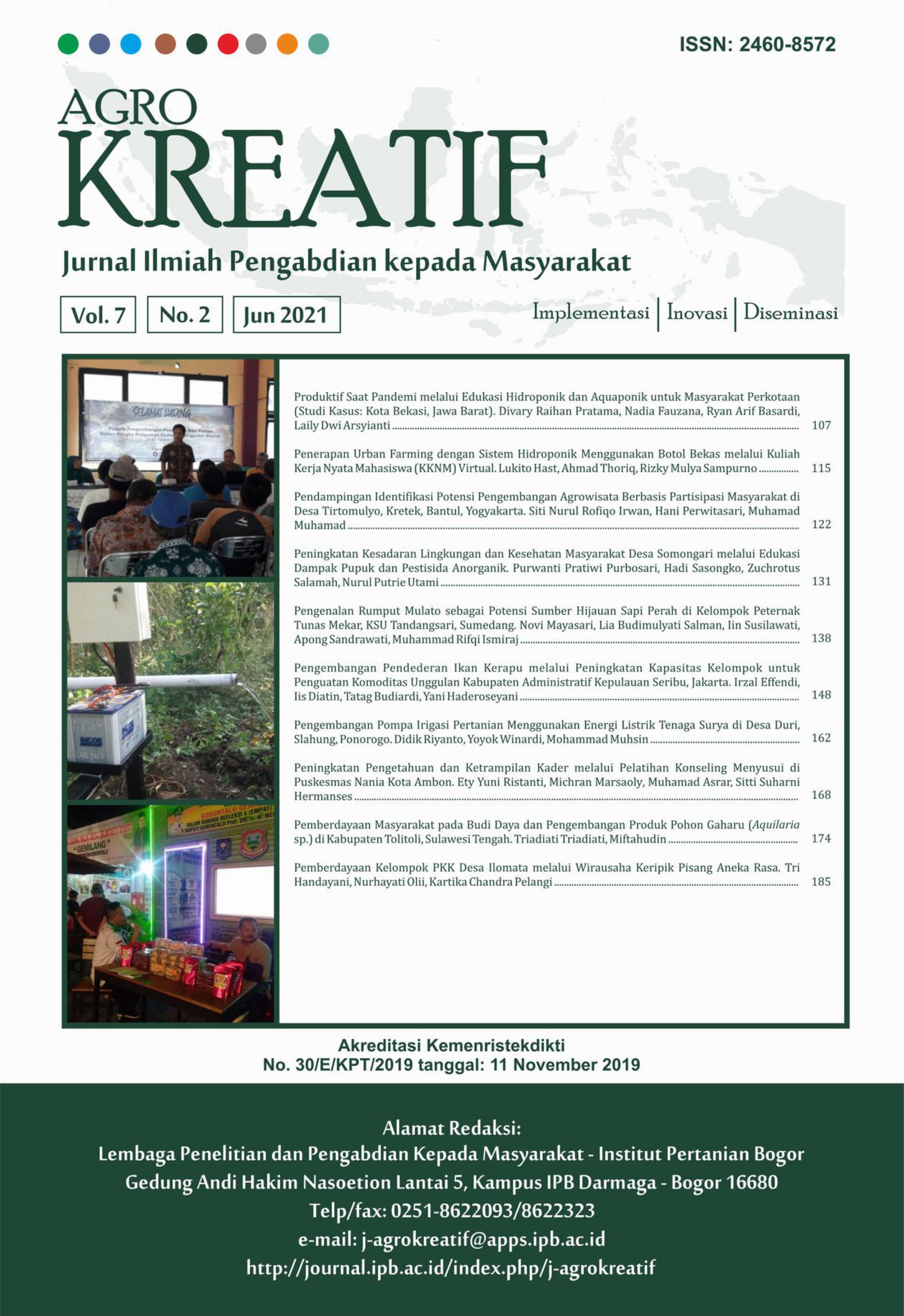Pengenalan Rumput Mulato sebagai Potensi Sumber Hijauan Sapi Perah di Kelompok Peternak Tunas Mekar, KSU Tandangsari, Sumedang
Abstract
The Tunas Mekar Farmer Group (TMFG) is a group of farmers belong to dairy farming cooperation (KSU) Tandangsari with the commodity of Friesian Holstein (FH) dairy cattle whose business objectives are to produce cow's milk and breeding of dairy cows. One of the problems that may have caused the low milk production was the result of the low quality and availability of the forage provided by the KPTM members. It is necessary to look for forage alternatives that have advantages in biomass and protein and fiber content, in the hope that it can help meet the nutritional needs of livestock. One of the forages that has advantages in protein and fiber content is mulato grass (Brachiaria hybrid cv. Mulato) which is reported to have the ability to live in a good dry season, easy to breed through tillers, and quite high palatability by ruminants. This community service is carried out to introduce and disseminate the potential benefits of mulato grass as a potential forage source for dairy cows. Community service activities are carried out with the exploratory stage, then the extension stage, and followed by the mentoring stage using an online platform (Whatsapp group). Community service activities regarding the potential of mulato grass as a forage for dairy cows were successfully implemented. With the enthusiasm of extension participants, extension activities can increase the insight of farmers participating in the extension, reflected in the success of farmers in planting and cultivating mulato grass.
Downloads
References
Brandan CP, Chavarría D, Huidobro J, Meriles JM, Brandan CP, Vargas Gil S. 2017. Influence of a tropical grass (Brachiaria brizantha cv. Mulato) as cover crop on soil biochemical properties in a degraded agricultural soil. European Journal of Soil Biology 83:84–90. https://doi.org/10.1016/j.ejsobi.2017.10.009
Djaya MS. 2014. Kecernaan in vitro dan serat kasar rumput mulato dan kalopo pada tingkat naungan dan sistem pertanaman yang berbeda. Polhasains: jurnal sains dan terapan Politeknik Hasnur. 3(01): 34–41.
Inyang U, Vendramini JMB, Sollenberger LE, Sellers B, Adesogan A, Paiva L, Lunpha A. 2010. Forage Species and Stocking Rate Effects on Animal Performance and Herbage Responses of ‘Mulato’ and Bahiagrass Pastures. Crop Science 50(3):1079–1085. https://doi.org/10.2135/cropsci2009.05.0267
Kusumo RAB, Sukayat Y, Heryanto MA, Wiyono SN. 2020. Budidaya sayuran dengan teknik vertikultur untuk meningkatkan ketahanan pangan rumah tangga di perkotaan. Dharmakarya 9(2):89–92. https://doi.org/10.24198/dharmakarya.v9i2.23470
Liu S, Zhang R, Kang R, Meng J, Ao C. 2016. Milk fatty acids profiles and milk production from dairy cows fed different forage quality diets. Animal Nutrition. 2(4): 329–333. https://doi.org/10.1016/j.aninu.2016.08.008
Makin M. 2012. Performa Sifat-Sifat Produksi Susu dan Reproduksi Sapi Perah Fries Holland Di Jawa Barat. Jurnal Ilmu Ternak Universitas Padjadjaran. 12(2): 39‒44.
Maranatha G, Manu AE, Sobang YUL, Samba FD, Pelokilla MR. 2019. The evaluation of nutritive value and in vitro digestibility of Mulato grass (Brachiaria hybrid cv. Mulato) grown under mixed culture system with legume and horticulture plants on dry land. In: IOP Conference Series: Earth and Environmental Science 387:12032. https://doi.org/10.1088/1755-1315/387/1/012032
Mutimura M, Ebong C, Rao IM, Nsahlai I V. 2017. Effect of cutting time on agronomic and nutritional characteristics of nine commercial cultivars of Brachiaria grass compared with Napier grass during establishment under semi-arid conditions in Rwanda. African journal of agricultural research. 12(35): 2692–2703. https://doi.org/10.5897/AJAR2017.12474
Purba NP, Faizal I, Setiwati D, Mulyani PG. 2020. Teknologi dan pendampingan monitoring perairan untuk budidaya di desa Babakan, kabupaten Pangandaran. Dharmakarya 9(1):12–15. https://doi.org/10.24198/dharmakarya.v9i1.21354
Ruhiyat R, Indrawati D, Indrawati E, Siami L. 2020. Pemberdayaan Masyarakat Melalui Sistem Pertanian Terpadu di Desa Cibodas Kecamatan Pasirjambu, Kabupaten Bandung. Agrokreatif: Jurnal Ilmiah Pengabdian kepada Masyarakat 6(2):97–104. https://doi.org/10.29244/agrokreatif.6.2.97-105
Suardin S, Sandiah N, Aka R. 2014. Kecernaan bahan kering dan bahan organik campuran rumput mulato (brachiaria hybrid. cv. mulato) dengan jenis legum berbeda menggunakan cairan rumen sapi. Jurnal Ilmu dan Teknologi Peternakan Tropis 1(1):16–22. https://doi.org/10.33772/jitro.v1i1.357
Wanapat M, Cherdthong A, Phesatcha K, Kang S. 2015. Dietary sources and their effects on animal production and environmental sustainability. Animal Nutrition. 1(3): 96–103. https://doi.org/10.1016/j.aninu.2015.07.004
Wang H, He Y, Li H, Wu F, Qiu Q, Niu W, Gao Z, Su H, Cao B. 2019. Rumen fermentation, intramuscular fat fatty acid profiles and related rumen bacterial populations of Holstein bulls fed diets with different energy levels. Applied Microbiology and Biotechnology. 103(12): 4931–4942. https://doi.org/10.1007/s00253-019-09839-3
This work is licensed under a Creative Commons Attribution-NonCommercial 4.0 International License.



















